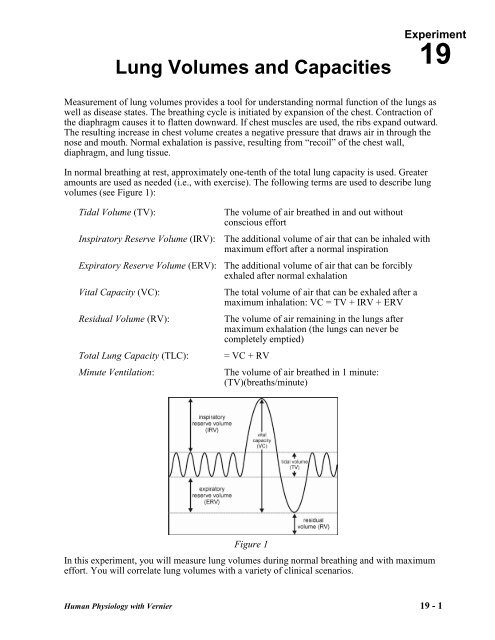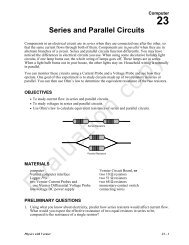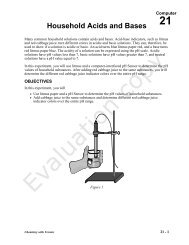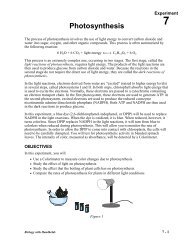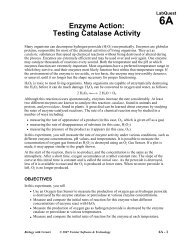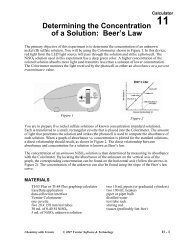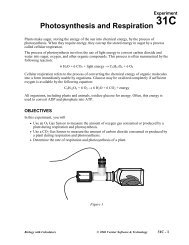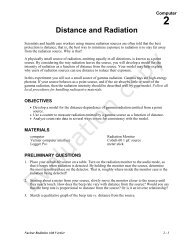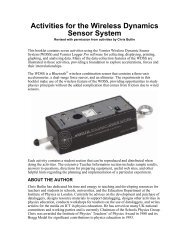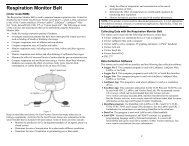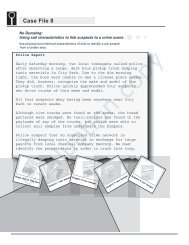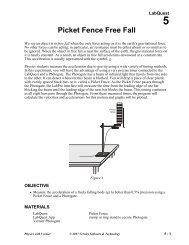Lung Volumes and Capacities
Lung Volumes and Capacities
Lung Volumes and Capacities
You also want an ePaper? Increase the reach of your titles
YUMPU automatically turns print PDFs into web optimized ePapers that Google loves.
<strong>Lung</strong> <strong>Volumes</strong> <strong>and</strong> <strong>Capacities</strong><br />
Experiment<br />
19<br />
Measurement of lung volumes provides a tool for underst<strong>and</strong>ing normal function of the lungs as<br />
well as disease states. The breathing cycle is initiated by expansion of the chest. Contraction of<br />
the diaphragm causes it to flatten downward. If chest muscles are used, the ribs exp<strong>and</strong> outward.<br />
The resulting increase in chest volume creates a negative pressure that draws air in through the<br />
nose <strong>and</strong> mouth. Normal exhalation is passive, resulting from “recoil” of the chest wall,<br />
diaphragm, <strong>and</strong> lung tissue.<br />
In normal breathing at rest, approximately one-tenth of the total lung capacity is used. Greater<br />
amounts are used as needed (i.e., with exercise). The following terms are used to describe lung<br />
volumes (see Figure 1):<br />
Tidal Volume (TV):<br />
The volume of air breathed in <strong>and</strong> out without<br />
conscious effort<br />
Inspiratory Reserve Volume (IRV): The additional volume of air that can be inhaled with<br />
maximum effort after a normal inspiration<br />
Expiratory Reserve Volume (ERV): The additional volume of air that can be forcibly<br />
exhaled after normal exhalation<br />
Vital Capacity (VC):<br />
Residual Volume (RV):<br />
Total <strong>Lung</strong> Capacity (TLC):<br />
Minute Ventilation:<br />
The total volume of air that can be exhaled after a<br />
maximum inhalation: VC = TV + IRV + ERV<br />
The volume of air remaining in the lungs after<br />
maximum exhalation (the lungs can never be<br />
completely emptied)<br />
= VC + RV<br />
The volume of air breathed in 1 minute:<br />
(TV)(breaths/minute)<br />
Figure 1<br />
In this experiment, you will measure lung volumes during normal breathing <strong>and</strong> with maximum<br />
effort. You will correlate lung volumes with a variety of clinical scenarios.<br />
Human Physiology with Vernier 19 - 1
Experiment 19<br />
OBJECTIVES<br />
In this experiment, you will<br />
• Obtain graphical representation of lung capacities <strong>and</strong> volumes.<br />
• Compare lung volumes between males <strong>and</strong> females.<br />
• Correlate lung volumes with clinical conditions.<br />
MATERIALS<br />
computer<br />
Vernier computer interface<br />
Logger Pro<br />
Vernier Spirometer<br />
disposable mouthpiece<br />
disposable bacterial filter<br />
nose clip<br />
PROCEDURE<br />
Important: Do not attempt this experiment if you are currently suffering from a respiratory<br />
ailment such as the cold or flu.<br />
1. Connect the Spirometer to the Vernier computer interface. Open the file “19 <strong>Lung</strong> <strong>Volumes</strong>”<br />
from the Human Physiology with Vernier folder.<br />
2. Attach the larger diameter side of a bacterial filter to the “Inlet” side of the Spirometer.<br />
Attach a gray disposable mouthpiece to the other end of the bacterial filter (see Figure 2).<br />
3. Hold the Spirometer in one or both h<strong>and</strong>s. Brace your arm(s) against a solid surface, such as a<br />
table, <strong>and</strong> click to zero the sensor. Note: The Spirometer must be held straight up <strong>and</strong><br />
down, as in Figure 2, <strong>and</strong> not moved during data collection.<br />
4. Collect inhalation <strong>and</strong> exhalation data.<br />
a. Put on the nose plug.<br />
b. Click to begin data collection.<br />
c. Taking normal breaths, begin data collection with an inhalation <strong>and</strong> continue to breathe in<br />
<strong>and</strong> out. After 4 cycles of normal inspirations <strong>and</strong> expirations fill your lungs as deeply as<br />
possible (maximum inspiration) <strong>and</strong> exhale as fully as possible (maximum expiration). It<br />
is essential that maximum effort be expended when performing tests of lung volumes.<br />
d. Follow this with at least one additional recovery breath.<br />
5. Click to end data collection.<br />
Figure 2<br />
19 - 2 Human Physiology with Vernier
<strong>Lung</strong> <strong>Volumes</strong> <strong>and</strong> <strong>Capacities</strong><br />
6. Click the Next Page button, , to see the lung volume data.<br />
If the baseline on your graph has drifted, use the Baseline<br />
Adjustment feature to bring the baseline volumes closer to<br />
zero, as in Figure 3.<br />
7. Select a representative peak <strong>and</strong> valley in the Tidal Volume<br />
portion of your graph. Place the cursor on the peak <strong>and</strong> click<br />
<strong>and</strong> drag down to the valley that follows it. Enter the ∆y<br />
value displayed in the lower left corner of the graph to the<br />
nearest 0.1 L as Tidal Volume in Table 1.<br />
8. Move the cursor to the peak that represents your maximum inspiration. Click <strong>and</strong> drag down<br />
the side of the peak until you reach the level of the peaks graphed during normal breathing.<br />
Enter the ∆y value displayed in the lower left corner of the graph to the nearest 0.1 L as<br />
Inspiratory Reserve Volume in Table 1.<br />
9. Move the cursor to the valley that represents your maximum expiration. Click <strong>and</strong> drag up<br />
the side of the peak until you reach the level of the valleys graphed during normal breathing.<br />
Enter the ∆y value displayed in the lower left corner of the graph to the nearest 0.1 L as<br />
Expiratory Reserve Volume in Table 1.<br />
10. Calculate the Vital Capacity <strong>and</strong> enter the total to the nearest 0.1 L in Table 1.<br />
VC = TV + IRV + ERV<br />
11. Calculate the Total <strong>Lung</strong> Capacity <strong>and</strong> enter the total to the nearest 0.1 L in Table 1. (Use the<br />
value of 1.5 L for the RV.)<br />
TLC = VC + RV<br />
12. Share your data with your classmates <strong>and</strong> complete the Class Average columns in Table 1.<br />
DATA<br />
Table 1<br />
Figure 3<br />
Volume measurement<br />
(L)<br />
Individual (L)<br />
Class average<br />
(Male)<br />
(L)<br />
Class average<br />
(Female)<br />
(L)<br />
Tidal Volume (TV)<br />
Inspiratory Reserve (IRV)<br />
Expiratory Reserve (ERV)<br />
Vital Capacity (VC)<br />
Residual Volume (RV) ≈1.5 ≈1.5 ≈1.5<br />
Total <strong>Lung</strong> Capacity<br />
(TLC)<br />
Human Physiology with Vernier 19 - 3
Experiment 19<br />
DATA ANALYSIS<br />
1. What was your Tidal Volume (TV) What would you expect your TV to be if you inhaled a<br />
foreign object which completely obstructed your right mainstem bronchus<br />
2. Describe the difference between lung volumes for males <strong>and</strong> females. What might account<br />
for this<br />
3. Calculate your Minute Volume at rest.<br />
(TV × breaths/minute) = Minute Volume at rest<br />
If you are taking shallow breaths (TV = 0.20 L) to avoid severe pain from rib fractures, what<br />
respiratory rate will be required to achieve the same minute volume<br />
4. Exposure to occupational hazards such as coal dust, silica dust, <strong>and</strong> asbestos may lead to<br />
fibrosis, or scarring of lung tissue. With this condition, the lungs become stiff <strong>and</strong> have more<br />
“recoil.” What would happen to TLC <strong>and</strong> VC under these conditions<br />
5. In severe emphysema there is destruction of lung tissue <strong>and</strong> reduced recoil. What would you<br />
expect to happen to TLC <strong>and</strong> VC<br />
6. What would you expect to happen to your Expiratory Reserve Volume when you are treading<br />
water in a lake<br />
EXTENSION<br />
Repeat the experiment with the chest or abdomen constricted (use a girdle or ace b<strong>and</strong>age).<br />
19 - 4 Human Physiology with Vernier
<strong>Lung</strong> <strong>Volumes</strong> <strong>and</strong> <strong>Capacities</strong><br />
1. The Spirometer should be held vertically <strong>and</strong> steadily. It is helpful to brace at least one arm<br />
on a hard surface, such as a table. Deviation from this position will affect data collection.<br />
2. To maintain good hygiene, use the Sprirometer with a MicroGard ® bacterial filter <strong>and</strong> a<br />
disposable mouthpiece. In an ideal situation, every student would have his or her own<br />
bacterial filter <strong>and</strong> disposable mouthpiece. However, budget restraints may require you to<br />
share the bacterial filter among a few students. According to the manufacturer’s specs, the<br />
MicroGard filters out more than 99% of bacterial <strong>and</strong> viral aerosols.<br />
3. It is important for students to begin data collection with an inspiration as this is the trigger for<br />
data collection to begin.<br />
4. Residual volume cannot be measured. A value of ≈1.5 L is provided for the purposes of this<br />
experiment.<br />
5. Expected ranges in Table 1 were gathered with clinically calibrated equipment <strong>and</strong> with<br />
professional coaching. Values in the classroom may vary.<br />
SAMPLE DATA<br />
Flow rate data representing regular breathing,<br />
a large inhale <strong>and</strong> exhale, <strong>and</strong> recovery<br />
Human Physiology with Vernier<br />
19 - 1 T
Experiment 19<br />
Table 1<br />
Volume measurement<br />
(L)<br />
Expected range<br />
(L)<br />
Individual<br />
(L)<br />
Class average<br />
(Male)<br />
(L)<br />
Class average<br />
(Female)<br />
(L)<br />
Tidal Volume (TV) xxx xxx xxx xxx<br />
Inspiratory Reserve (IRV) xxx xxx xxx xxx<br />
Expiratory Reserve (ERV) xxx xxx xxx xxx<br />
Vital Capacity (VC) xxx xxx xxx xxx<br />
Residual Volume (RV) xxx xxx xxx xxx<br />
Total lung Capacity (TLC) xxx xxx xxx xxx<br />
ANSWERS TO THE DATA ANALYSIS QUESTIONS<br />
Answers have been removed from the online versions of Vernier<br />
curriculum material in order to prevent inappropriate student use.<br />
Graphs <strong>and</strong> data tables have also been obscured. Full answers <strong>and</strong><br />
sample data are available in the print versions of these labs.<br />
19 - 2 T Human Physiology with Vernier


